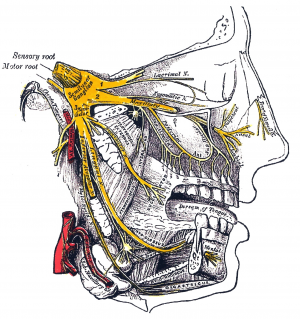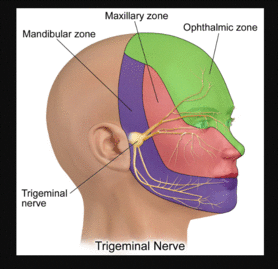Trigeminal Nerve: Difference between revisions
No edit summary |
No edit summary |
||
| Line 4: | Line 4: | ||
'''Top Contributors''' - {{Special:Contributors/{{FULLPAGENAME}}}} | '''Top Contributors''' - {{Special:Contributors/{{FULLPAGENAME}}}} | ||
</div>[[File:Trigeminal Nerve Gray778 .png| | </div> | ||
[[File:Trigeminal Nerve Gray778 .png|thumb|Trigeminal Nerve ]] | |||
== Description == | == Description == | ||
The Trigeminal Nerve (TNr) is the fifth [[Cranial Nerves|cranial nerve]]. It is also represented as CN V. It is the largest of all the cranial nerves. It is also the most complex of all the cranial nerves as it has an extensive anatomic course. Knowing its course further helps in understanding the relationship between the brainstem, skull base, and facial area. | The Trigeminal Nerve (TNr) is the fifth [[Cranial Nerves|cranial nerve]]. It is also represented as CN V. It is the largest of all the cranial nerves. It is also the most complex of all the cranial nerves as it has an extensive anatomic course. Knowing its course further helps in understanding the relationship between the brainstem, skull base, and facial area. | ||
Revision as of 18:28, 15 October 2020
Original Editor - Saumya Srivastava
Top Contributors - Saumya Srivastava, Riccardo Ugrin, Wendy Walker, Kim Jackson, Vidya Acharya and Ahmed M Diab
Description[edit | edit source]
The Trigeminal Nerve (TNr) is the fifth cranial nerve. It is also represented as CN V. It is the largest of all the cranial nerves. It is also the most complex of all the cranial nerves as it has an extensive anatomic course. Knowing its course further helps in understanding the relationship between the brainstem, skull base, and facial area.
Trigeminal nerve is a mixed nerve - having both sensory and motor fibres. The origin of the trigeminal nerve is the annular protuberance at the limit of the cerebellar peduncles[1]. It originates from three sensory nuclei (mesencephalic, principal sensory, spinal nuclei of trigeminal nerve) and one motor nucleus (motor nucleus of the trigeminal nerve) extending from the midbrain to the medulla[2].
Distal Roots -[edit | edit source]
- The sensory nuclei merge to form the sensory root at the level of the pons and the motor nucleus continues to form the motor root.
- As a result the sensory root is large (made up of about 50 fascicles)[1], while the motor root is more slender (composed of six or seven fascicles)[1].These roots are analogous to the dorsal and ventral roots of the spinal cord[2]
- The sensory root then expands into the trigeminal ganglion, in the middle of the cranial fossa. The trigeminal ganglion is located lateral to the cavernous sinus, in a depression of the temporal bone, known as the trigeminal cave[2].
Peripheral Divisons of The TNr into Branches-[edit | edit source]
The TNr divides into 3 nerves distal to the trigeminal ganglion[3] -
- The Ophthalmic nerve, passes forward in the lateral wall to the cavernous sinus. It then enters the orbit via the superior orbital fissure.
- The Mandibular nerve, runs laterally along the skull base then exits the cranium by descending through the foramen ovale into the masticator space. The motor root of the trigeminal nerve bypasses the trigeminal ganglion and reunites with the mandibular nerve in the foramen ovale basis cranii
- The Maxillary nerve, leaves the skull base through the foramen rotundum ossis sphenoidalis, inferolateral to the cavernous sinus. It then enters the pterygopalatine fossa, giving off several branches. The main trunk then continues anteriorly in the orbital floor and emerges onto the face as the infraorbital nerve
Function[edit | edit source]
It is a mixed nerve - the sensory part of the nerve supplies the face and the motor for muscles of mastication[3]
Motor -[edit | edit source]
- The motor root of the trigeminal nerve bypasses the trigeminal ganglion and reunites with the mandibular nerve in the foramen ovale basis cranii.
- The motor root of the mandibular nerve innervates the four muscles of mastication:
- the mylohyoid,
- the anterior belly of digastric,
- the tensor muscle of the tympanic membranes, and
- tensor muscle of valum palatinum
Sensory[edit | edit source]
Clinical relevance[edit | edit source]
Assessment[edit | edit source]
Treatment[edit | edit source]
Resources[edit | edit source]
References[edit | edit source]
- ↑ 1.0 1.1 1.2 Barral JP, Croibier A. Trigeminal nerve. In:Barral JP, Croibier A editor(s). Manual Therapy for the Cranial Nerves. Churchill Livingstone, 2009, Pages 107-114,
- ↑ 2.0 2.1 2.2 Pazhaniappan N. The Trigeminal Nerve (CN V). Available from:https://teachmeanatomy.info/head/cranial-nerves/trigeminal-nerve/. (accessed 14 October 2020)
- ↑ 3.0 3.1 Kamal H.A.M, Toland J. Trigeminal Nerve Anatomy: Illustrated Using Examples of Abnormalities. American Journal of Roentgenology. 2001;176: 247-251.
Original Editor - Saumya Srivastava
Top Contributors - Saumya Srivastava, Riccardo Ugrin, Wendy Walker, Kim Jackson, Vidya Acharya and Ahmed M Diab








